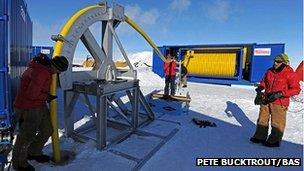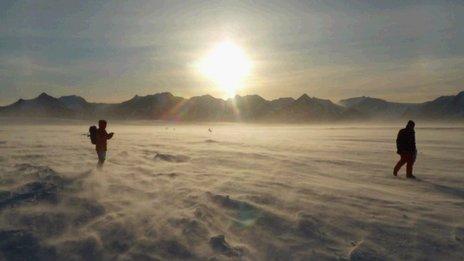Lake Ellsworth: Drilling effort runs into trouble
- Published

The drilling operation began last week
A British attempt to search for life in an ancient lake beneath the Antarctic ice-sheet has run into trouble.
The team has reported "a serious problem" with the main boiler used to heat the water that powers a drill.
Work was halted on Saturday in what could prove to be a major blow to the project to investigate sub-glacial Lake Ellsworth.
The aim is to use 90C water to blast a hole through the two-mile-thick ice-sheet to reach the lake waters below.
The research goal is to gather samples of water and sediment to search for signs of life and clues about the region's climatic history.
Prof Martin Siegert, chief scientist of the project, said: "The technical difficulties are something that are not unfamiliar in Antarctica - it's a hostile environment and very difficult to do things smoothly.
"The good news is that we found the fault relatively early on in our deployment system and so we have quite a lot of fuel that is left remaining. If we didn't have that of course we wouldn't be able to continue any further.
The project relies on the successful operation of the hot-water drill which in turn depends on the boiler.
Last Thursday the team reported that a key circuit on the boiler - controlling the primary burner - had failed to start.
A back-up burner was fitted which ran successfully for 4-5 days - enough to melt the water needed to start drilling.

The waters beneath the ice may have been isolated for up to half a million years
The first task was to melt a cavity 300m below the ice to act as a water store to help balance water pressure once the main drilling to the lake started.
In a statement released this morning, the team announced: "Unfortunately, the burner failed at approximately 3pm local time on Saturday."
A replacement component has been ordered and is expected to reach the team in a few days' time.
"In the meantime," the statement says, "the engineering team is in contact with the manufacturers of the units who are helping them to determine the cause of the malfunction.
"Both units demonstrated the same problem. When the replacement circuit arrives the engineers will work with the manufacturer to go through the set up procedure. The team is hopeful that this will solve the problem."
"If not, a further option is to attempt to bypass the circuit and manually "drive" the burner. The team is discussing operating protocols with the manufacturer before exploring this option further."

They will now have to wait for a replacement circuit
Project manager Chris Hill told BBC News in an email that the boiler was currently running on a back-up electric element which is not powerful enough to heat the water to the temperature needed for drilling.
"We are also vulnerable if this element fails, we will have to fully drain down the system…and start over from scratch - this would be a big deal."
A major concern is that the system was designed to be operated on one attempt - to heat the water and melt open the bore-hole without pause to avoid the risk of ice forming inside the drill-pipe.
However sources at the British Antarctic Survey say there is no issue of any water having frozen in the pipes. They say the system is still "ticking over" with warm water.
In temperatures as low as minus 30C, and in a region notorious for its winds and remoteness, any technical problems of this scale are a huge challenge.
Martin Siegert commented: "We're working very hard to make sure things are right here. It's not the end of the field season by any means and with our suppliers in the UK and the expertise we have on site we're hopeful to restart drilling in a few days' time."
The team always recognized that the project involved high risks - with sophisticated technology in a hostile environment.
It is unlikely that the team will resume drilling before Friday 21 December.
- Published10 December 2012
- Published12 December 2012
- Published10 August 2012
